Railroad adventure VI: Taiwan High Speed Rail
My blogging has suffered from all the work of finishing my book, on which I also spent much of my free time in Japan. So I have many things still to say about what I have been doing in the last few weeks, which have included trips for lecturing to Taiwan and Japan.
In Taiwan, I had the pleasure of experiencing the Taiwanese bullet train. Very pleasant.
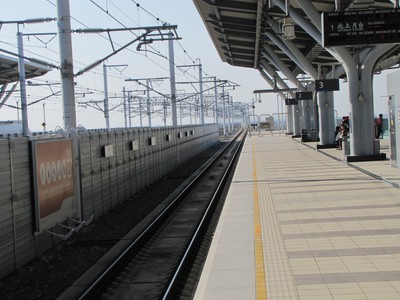
The rail line was of course very straight. To take this photo, I stepped over the yellow line. Immediately, a guard blew his whistle and signed for me to step back behind it. I had of course checked carefully that there was no train anywhere close to where we were.

The train eventually arrived. Exactly on time, of course!
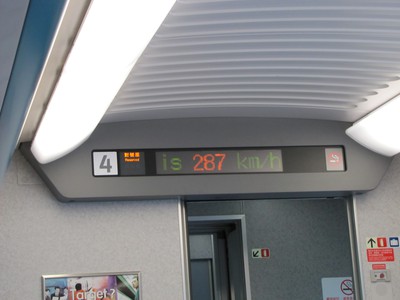
We made up to 290 km/h, but I have picture evidence only for 287. You'll just have to trust me for the last 3 kms! Despite the speed, the train ran more smoothely than the small train between Ludvika and Västerås, and of course much, much faster. Actually, I think this was much smoother than SJ's vaunted X2000 express train. The Swedish government is cutting funding for track maintenance, apparently wishing to go down the same drain as the USA both for communications and for highschool education (where Sweden is already almost there).
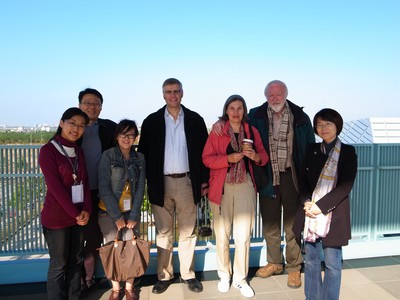
The happy travellers on the way back from the conference, together with our gracious Taiwanese minders.
In Taiwan, I had the pleasure of experiencing the Taiwanese bullet train. Very pleasant.

The rail line was of course very straight. To take this photo, I stepped over the yellow line. Immediately, a guard blew his whistle and signed for me to step back behind it. I had of course checked carefully that there was no train anywhere close to where we were.

The train eventually arrived. Exactly on time, of course!

We made up to 290 km/h, but I have picture evidence only for 287. You'll just have to trust me for the last 3 kms! Despite the speed, the train ran more smoothely than the small train between Ludvika and Västerås, and of course much, much faster. Actually, I think this was much smoother than SJ's vaunted X2000 express train. The Swedish government is cutting funding for track maintenance, apparently wishing to go down the same drain as the USA both for communications and for highschool education (where Sweden is already almost there).

The happy travellers on the way back from the conference, together with our gracious Taiwanese minders.
I have finally finished my book
My next book, The Conversion of Scandinavia: Vikings, Merchants, and Missionaries in the Remaking of Northern Europe, is now safely submitted to the publisher, Yale University Press. In the end, it came out at 91,801 words in a preface, an introduction, and twelve chapters. It is such a relief to get this off my shoulders, after years and years of work, during which I have actually drafted the book three times. I was not happy with either of the first two drafts (neither of which was entirely complete), so they went into the recycling bin. Now I am happy enough with the result, and it will be exciting to see what reactions I will get.
I think the cover will be honored with this beautiful image of a Viking-Age armring in the shape of a snake or a dragon from Northern Sweden.
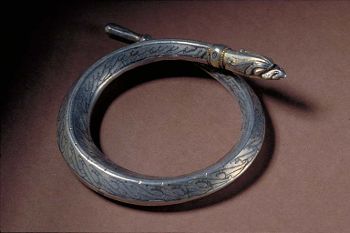
Note: I have the proper permissions to print the image in the book, but not here on the blog, so what you see above is actually an image published by the Historiska museet on their website and linked from here. The original context is here.
I think the cover will be honored with this beautiful image of a Viking-Age armring in the shape of a snake or a dragon from Northern Sweden.
Note: I have the proper permissions to print the image in the book, but not here on the blog, so what you see above is actually an image published by the Historiska museet on their website and linked from here. The original context is here.
Sapporo
Sapporo is a pleasant relatively small city. I have admired the view from the tallest building in town, eaten tempura and drank Sapporo classic beer, and in general had a good time. And I have used the most gorgeous public bathroom I have ever seen. There will be photos later.
Sushi on 35 floor and goodbye Tokyo
This evening our hosts took us out to a very nice sushi restaurant on the 35th floor of a building close to Tokyo railway station, thus close also to the Imperial Palace. It was a wonderful dinner. I though I have had good sushi before, but that cannot compare to this experience. Wonderful!
Tomorrow I am going on to Sapporo.
Tomorrow I am going on to Sapporo.
Railroad adventure VII: Shinkansen Tokyo-Niigata
Shinkansen means "new main line." The trains are also known in English as "bullet train". The tracks are very straight, and the trains go up to 300 km/h. There were, unfortunately, no announcements of the speed on the trains I took, so I do not know how fast we travelled. We got from Tokyo to Niigata in quite exactly 2 hours, and the ride was very comfortable in cars with two levels.


Niigata
Niigata is a relatively small city on the west coast of Japan with some 500,000 inhabitants. We got her by a Shikansen bullet train, which went really fast, I do not know how fast. There was a sign that stated that the maximum speed of the train was 311 km/h, but our hosts claimed that the Niigata train does not go that fast. It went very fast at any rate. The track was, of course, very straight, went through many long tunnels, and the train was not very full at all. We had plenty of space. I spoke a lot with Frau Landau during the trip, for we sat next to each other.
I just continue to be amazed at the splendid hospitality offered by our Japanese hosts. Today we had lunch in one of those classic Japanese buildings, about 100 years old, with paper walls, many exquisite wood carvings and a beautiful Japanese garden outside. We ate at one of those very low tables. The Japanese sat on their knees, while they had provided low chairs for us foreigners. A very good lunch, with sashimi, teryaki, miso soup, and much else that was very tasty. The entire scen was just like a scene of what one images Japan to be like but that one, on more careful thought, realizes probably does not exist anymore. But we experienced it, and will not soon forget.


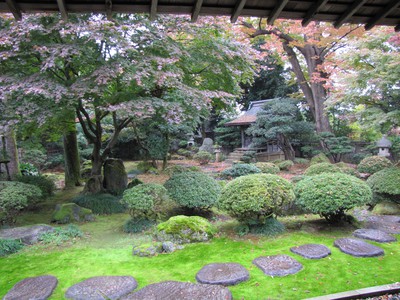

I just continue to be amazed at the splendid hospitality offered by our Japanese hosts. Today we had lunch in one of those classic Japanese buildings, about 100 years old, with paper walls, many exquisite wood carvings and a beautiful Japanese garden outside. We ate at one of those very low tables. The Japanese sat on their knees, while they had provided low chairs for us foreigners. A very good lunch, with sashimi, teryaki, miso soup, and much else that was very tasty. The entire scen was just like a scene of what one images Japan to be like but that one, on more careful thought, realizes probably does not exist anymore. But we experienced it, and will not soon forget.




We have a very pleasant and luxurious hotel. I was very pleasantly surprised by the audience at my talk: many professors and even the dean was there, and many students. They were all paying careful attention and made notes. And everyone stayed the two and half hours we were going on (a lot of translating between Japanese and English/German was going on). I gave my paper, which I liked better today than when I gave it in Tokyo (I had been asked to give the same paper in both places), and Peter Landau made a very thoughtful and positive comment afterwards.

We had many very intelligent questions, and afterwards a cocktail party with as much sushi and sashimi as I ever could hope to eat. Wonderful! I spoke with several Japanese colleagues, who made a very good impression - I made several friends, I think -, and also a little with some students, but they seemed unduly shy. All in all as good an academic experience I have ever had.

The old bridge in Niigata seems to be something of a symbol of the town.

We had many very intelligent questions, and afterwards a cocktail party with as much sushi and sashimi as I ever could hope to eat. Wonderful! I spoke with several Japanese colleagues, who made a very good impression - I made several friends, I think -, and also a little with some students, but they seemed unduly shy. All in all as good an academic experience I have ever had.

The old bridge in Niigata seems to be something of a symbol of the town.
Tokyo
I arrived in Tokyo on Friday evening, just missing a minor earthquake. It has been an intense but very satisfying time since then. I am staying in a hotel that also serves as Tokyo University's guest house.

The hotel is very quiet and comfortable. The room is small, but the bed is full size.
On Saturday we first had a great lunch in a restaurant on the top floor of the university hospital, with an amazing view over Tokyo. Then I and Peter Landau gave our lectures. Here is Landau, who identified the famous (but so far anonymous) Archpoet with a named twelfth-century jurist.

After the talks, which together went on for something like four hours (including the questions and answers afterwards, which took some extra time since some of the conversation there was translated between Japanese and German), we had a wonderful dinner at a Chinese restaurant in the Ginza district. We had very much very good food, including shark fin soup, Peking Duck, and dumplings.
On Sunday we visited a museum which actually was inside a shopping mall. The museum had a very beautiful exhibit of woodblock prints from the late eighteenth century (and a few from the very beginning of the nineteenth). We also walked around a little in the mall, where we had a light lunch.
The photo below is from the mall.

Hjalmar spelar fiol på skype
Den här veckan är Hjalmar ledig från skolan hela veckan, så idag ringde han till mig. Jag fick lyssna när han spelade fiol. Han är jätteduktig på att spela och han spelade fyra olika melodier. Min favorit är nog Fransk folkvisa.


Elsa är på dagis, så henne pratade jag inte med idag, men jag pratade med henne tidigare i veckan.


Elsa är på dagis, så henne pratade jag inte med idag, men jag pratade med henne tidigare i veckan.
